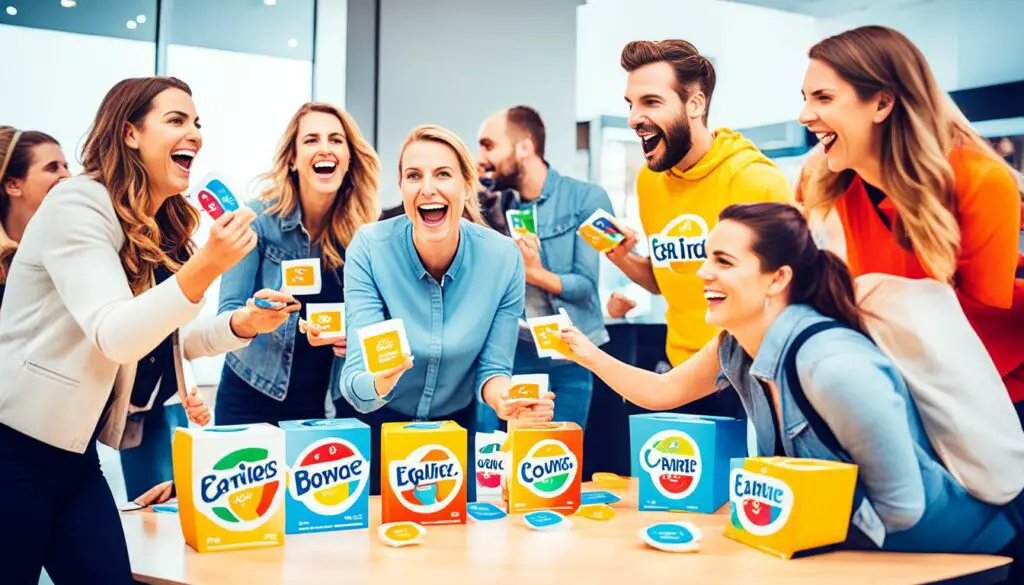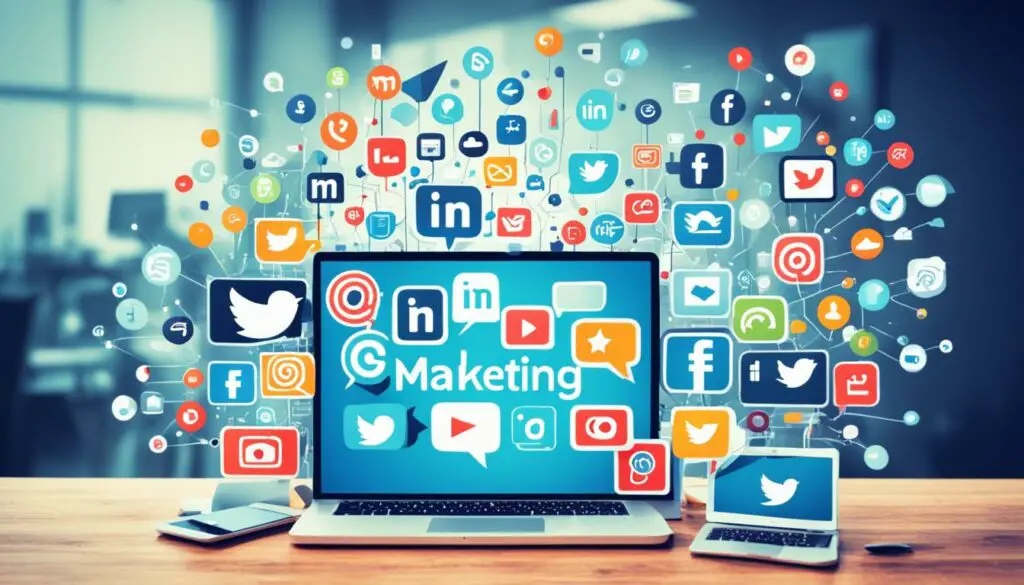Above the line (ATL) marketing is a powerful advertising strategy that utilizes traditional mass media channels to reach a broad audience. This form of marketing encompasses mediums such as television, radio, print, outdoor advertising, and more. By leveraging these mass media platforms, companies can effectively create brand awareness and connect with a large number of potential customers.
Key Takeaways:
- Above the line marketing (ATL) targets a wide audience through traditional mass media channels.
- ATL strategies include TV advertising, radio advertising, print advertising, outdoor advertising, and more.
- Successful ATL marketing campaigns include Coca-Cola’s “Share a Coke,” Nike’s “Just Do It,” and Apple’s “Think Different.
- ATL marketing is effective for generating brand awareness and reaching a large audience.
- ATL marketing can be expensive and challenging to measure its effectiveness.
Understanding ATL Marketing
ATL marketing, short for Above The Line marketing, is a strategic approach that utilizes mass media channels to reach a wide audience and create brand awareness. This type of marketing involves traditional advertising methods such as television, radio, print, and outdoor advertising. ATL marketing aims to generate significant exposure and establish a strong brand presence.
Although ATL marketing can be expensive and challenging to measure its effectiveness accurately, it offers several advantages. One of the primary benefits is the broad reach it provides, allowing companies to connect with a large number of potential customers. By leveraging mass media channels, ATL marketing can effectively capture the attention of a diverse audience and increase brand visibility.
Another key advantage of ATL marketing is its ability to build and reinforce brand identity. Through consistent and widespread messaging across various media platforms, companies can create a strong brand image and establish a distinct position in the market. This brand building process enhances customer recognition and loyalty.
Examples of Successful ATL Marketing Campaigns
Coca-Cola’s “Share a Coke” campaign, Nike’s “Just Do It” campaign, and Apple’s “Think Different” campaign are prominent examples of successful above the line (ATL) marketing campaigns.
Coca-Cola’s “Share a Coke” Campaign
Coca-Cola’s “Share a Coke” campaign was an innovative and highly successful example of ATL marketing. The campaign involved personalizing Coke bottles with popular names, resulting in a personalized and engaging experience for consumers. By putting popular names on their bottles, Coca-Cola created a sense of belonging and encouraged people to share their Coke experience on social media, resulting in increased sales and widespread brand recognition.
Nike’s “Just Do It” Campaign
Nike’s “Just Do It” campaign is one of the most iconic examples of ATL marketing. Launched in 1988, the campaign featured famous athletes and promoted the idea of pushing boundaries and achieving greatness. By associating their brand with renowned athletes such as Michael Jordan and Serena Williams, Nike successfully positioned itself as a leading sportswear brand and inspired millions of people around the world to pursue their dreams and embrace the spirit of “Just Do It.”
Apple’s “Think Different” Campaign
Apple’s “Think Different” campaign, introduced in 1997, was a pivotal moment in the company’s history. The campaign aimed to position Apple as an innovative brand that challenges the status quo. It featured iconic figures such as Albert Einstein, Mahatma Gandhi, and John Lennon, highlighting the message that great thinkers and innovators “think different.” This campaign helped Apple reestablish its brand identity and resonated with consumers who embraced the company’s unconventional and visionary approach.
What is Below The Line (BTL) Marketing?
Below The Line (BTL) marketing is a targeted and direct approach to marketing that focuses on specific individuals or small groups. Unlike Above The Line (ATL) marketing, which utilizes mass media channels to reach a wide audience, BTL marketing employs personalized strategies to engage with a select consumer base.
BTL marketing encompasses a range of activities, including direct mail campaigns, email marketing, experiential marketing, and promotional events. These tactics enable marketers to establish meaningful connections with customers and drive tailored messaging that resonates on a personal level.
Advantages of BTL Marketing
BTL marketing offers several advantages that make it a valuable component of a comprehensive marketing strategy:
- Cost-effectiveness: BTL marketing activities are often more budget-friendly compared to ATL marketing. With targeted campaigns, businesses can optimize their resources and allocate investments where they are most impactful.
- Targeted messaging: BTL marketing allows businesses to tailor their messages according to specific customer segments or individual preferences. This personalized approach enhances relevance, engagement, and the likelihood of converting prospects into loyal customers.
- Personalization: BTL marketing enables businesses to customize experiences for consumers, making them feel valued and fostering stronger relationships. Personalized marketing can include personalized emails, direct mail with personalized content, or interactive experiences at promotional events.
- Trackability: BTL marketing campaigns often provide measurable results, allowing marketers to track and analyze key performance indicators. This data-driven approach enables businesses to refine their strategies, optimize their marketing efforts, and improve return on investment (ROI).
Image
Table
| Advantages of BTL Marketing |
|---|
| Cost-effectiveness |
| Targeted messaging |
| Personalization |
| Trackability |
Examples of BTL Marketing Strategies
BTL marketing strategies encompass a range of tactics that target specific audiences and create personalized experiences. By focusing on direct customer interaction, BTL strategies are highly effective in driving consumer action and increasing brand engagement. Some notable examples of BTL marketing strategies include:
1. Direct Mail Marketing
Direct mail marketing involves sending personalized messages and promotional materials directly to targeted customers’ mailboxes. This marketing approach allows brands to deliver tailored content, such as exclusive offers or product information, which can significantly increase the likelihood of a response and conversion.
2. Sponsorship
Sponsorship is a BTL marketing strategy that allows brands to associate themselves with specific events, organizations, or individuals to reach new audiences and enhance brand visibility. By sponsoring relevant events or partnering with influencers, brands can improve their publicity and connect with their target market in a more personal and memorable way.
3. Brand Activation
Brand activation is an immersive BTL marketing technique that aims to engage consumers and drive brand loyalty through interactive experiences. These experiences can range from experiential events, pop-up shops, or branded installations that allow customers to interact with the brand and its products. Successful brand activations create lasting impressions and foster a stronger emotional connection between consumers and the brand.
4. In-Store Marketing
In-store marketing refers to various promotional activities carried out within retail stores to encourage customers to make a purchase. This includes point-of-purchase displays, product demonstrations, samples, and loyalty programs. By strategically placing these marketing efforts within the shopping environment, brands can capture consumers’ attention at the point of decision-making and increase sales.
To illustrate the effectiveness of BTL marketing strategies, let’s take a look at the following table showcasing the outcomes of real-life BTL campaigns:
| Marketing Strategy | Objective | Outcome |
|---|---|---|
| Direct Mail Marketing | Generate leads | Increase in customer inquiries by 20% |
| Sponsorship | Enhance brand visibility | 20% increase in social media followers |
| Brand Activation | Drive customer engagement | 100% increase in foot traffic to the activation venue |
| In-Store Marketing | Encourage product purchase | 30% uplift in sales for promoted products |
These examples demonstrate the effectiveness of BTL marketing strategies in achieving specific goals and driving favorable outcomes for brands. By leveraging personalized communication, targeted experiences, and strategic placement, BTL marketing strategies can effectively capture consumers’ attention and create meaningful connections.

The Role of BTL Marketing in Email Marketing Campaigns
BTL marketing plays a crucial role in enhancing the effectiveness of email marketing campaigns. By incorporating below the line (BTL) strategies, businesses can deliver personalized and targeted messages to their audience, resulting in higher engagement and conversion rates. Let’s explore some examples of how BTL marketing techniques can be used in email marketing:
Welcome Emails
A welcome email is a perfect opportunity to make a good first impression on new subscribers. It sets the tone for the relationship between the brand and the customer. With BTL marketing, businesses can create personalized welcome emails that address the unique needs and preferences of each recipient. This allows for a more personalized experience and helps to establish a strong connection from the start.
Abandoned Cart Emails
Abandoned cart emails are a powerful tool for recovering potential sales. By analyzing customer behavior and integrating BTL marketing tactics, businesses can send targeted and persuasive emails to remind customers about the products they left behind. These emails can include personalized offers, discounts, or limited-time promotions, enticing customers to complete their purchase and boosting conversion rates.
Birthday or Anniversary Emails
Sending birthday or anniversary emails is an effective way to engage customers and foster customer loyalty. By utilizing BTL marketing strategies, brands can create personalized emails that celebrate special occasions and offer exclusive discounts or rewards. This not only makes customers feel appreciated but also encourages them to make a purchase, driving sales and brand loyalty.
Re-engagement Emails
Re-engagement emails are designed to win back customers who have become inactive or disengaged. By employing BTL marketing techniques, businesses can send targeted and relevant emails to reignite the interest of these customers. These emails may include personalized offers, product recommendations based on previous purchases, or even surveys to gather feedback and understand customer preferences better.
By integrating BTL marketing strategies into email marketing campaigns, businesses can deliver highly personalized and targeted messages that resonate with their audience. This results in improved engagement, higher conversion rates, and increased customer loyalty. Take advantage of BTL marketing techniques to make your email campaigns more effective and drive meaningful results.
The Power of Email Signature Marketing
Email signature marketing is a powerful tool that every business should utilize in their marketing strategy. By including marketing messages or calls-to-action (CTAs) in your email signatures, you can effectively promote your brand and drive customer engagement. Let’s explore the benefits and potential of email signature marketing.
Personalization and Brand Consistency
One of the key advantages of email signature marketing is the ability to personalize your messages. By tailoring your signature content to the recipient, you can create a sense of connection and relevance. Whether it’s adding the recipient’s name, customizing the design, or providing personalized offers, personalization enhances the overall customer experience.
In addition to personalization, email signature marketing allows you to maintain brand consistency. Including your logo, brand colors, and contact information in your email signatures reinforces your brand identity and increases brand recognition. Consistent branding also helps build trust and credibility with your audience.
Increased Visibility and Cost-Effectiveness
Email signatures are an often-overlooked marketing space that can generate significant visibility for your brand. With every email you send, your signature is displayed, providing a constant reminder of your business and its offerings.
Compared to other marketing channels, email signature marketing is highly cost-effective. Once you have established your email signature template, it requires minimal effort and resources to implement and maintain. It is a budget-friendly way to reach your audience and amplify your marketing messages.
Call-to-Action and Measurable Results
Including clear and compelling CTAs in your email signatures encourages recipients to take action. Whether it’s directing them to your website, promoting a limited-time offer, or inviting them to follow your social media channels, CTAs drive engagement and conversions.
The beauty of email signature marketing is its measurability. You can track the performance of your CTAs using analytics tools, gaining valuable insights into the effectiveness of your signature campaigns. This data allows you to refine your strategies and optimize future campaigns for better results.
Email signature marketing offers numerous benefits including personalization, brand consistency, increased visibility, cost-effectiveness, and powerful CTAs. It’s a simple yet effective way to enhance your email communication and leverage every opportunity to promote your brand. Maximize the potential of your email signatures and take your marketing efforts to the next level.
What is Through The Line (TTL) Marketing?
TTL marketing, also known as Through The Line marketing, is a comprehensive approach that combines elements of both Above The Line (ATL) and Below The Line (BTL) marketing strategies. By integrating ATL and BTL methods, TTL marketing aims to achieve brand awareness and targeted conversions by leveraging the strengths of mass marketing and direct marketing approaches.
TTL marketing encompasses a wide range of tactics and channels, including traditional media, digital marketing, experiential marketing, direct mail, email marketing, and more. It allows marketers to create integrated campaigns that reach a broad audience while targeting specific individuals or smaller groups.
The integration of ATL and BTL strategies in TTL marketing enables businesses to benefit from the broad reach and brand-building capabilities of ATL, as well as the cost-effectiveness, personalization, and trackability of BTL. This synergy between the two approaches results in more effective and efficient marketing campaigns.
One of the key aspects of TTL marketing is the emphasis on 360-degree marketing, which involves considering all touchpoints throughout the customer journey. This holistic approach ensures consistent brand messaging and maximizes the impact of marketing efforts across various channels and interactions.
In the digital age, TTL marketing also embraces digital marketing strategies, including personalized communication, targeted advertising, and better ROI measurement. These digital tactics enhance the effectiveness of TTL campaigns by delivering relevant messages to specific target groups and allowing for precise tracking and analysis of campaign performance.
Integration of ATL and BTL Strategies in TTL Marketing
Through The Line marketing integrates ATL and BTL strategies to create cohesive and synchronized marketing campaigns. ATL strategies focus on reaching a wide audience through mass media channels, while BTL strategies target specific individuals or smaller groups through personalized and direct marketing tactics.
By combining ATL and BTL strategies, TTL marketing achieves a balance between brand awareness and targeted conversions. ATL tactics like TV advertising or outdoor billboards help create brand recognition and reach a large audience, while BTL tactics such as direct mail or email marketing deliver personalized messages to engage and convert specific individuals.
The integration of ATL and BTL strategies in TTL marketing allows for a more comprehensive and effective approach to marketing. It ensures that campaigns are not only visible to a broad audience but also resonate with targeted individuals, leading to better engagement and higher conversion rates.
Overall, TTL marketing provides a strategic framework for businesses to leverage both mass marketing and direct marketing tactics and achieve their marketing objectives more efficiently and effectively.
| Advantages of TTL Marketing |
|---|
| 1. Broad brand awareness through ATL strategies |
| 2. Personalization and targeted messaging through BTL strategies |
| 3. Cost-effectiveness of BTL tactics |
| 4. Trackability and measurement of campaign performance |
| 5. 360-degree marketing approach considering all touchpoints |
| 6. Integration of digital marketing for enhanced effectiveness |
The Importance of 360-Degree Marketing
360-degree marketing is an essential strategy for businesses aiming to maximize their marketing efforts and achieve optimal results. It involves the integration of above the line (ATL) and below the line (BTL) strategies to create comprehensive campaigns that reach a wide audience while targeting specific individuals. This approach ensures that every touchpoint and channel throughout the customer journey is leveraged to its full potential, offering a holistic and cohesive marketing experience.
One of the key benefits of 360-degree marketing is its ability to effectively build and strengthen a brand. By combining ATL tactics such as mass media advertising and BTL tactics like personalized direct marketing, businesses can create a consistent and compelling brand image that resonates with customers. Consistency across all marketing channels and touchpoints helps to establish brand recognition, loyalty, and trust.
Furthermore, 360-degree marketing allows businesses to optimize conversions by reaching the right customers at the right time. By considering the various stages of the customer journey and implementing targeted marketing strategies, businesses can guide potential customers through the conversion funnel and ultimately drive sales. Integrated campaigns enable personalized messaging and tailored content delivery, increasing the chances of conversions and maximizing ROI.
When businesses take a 360-degree marketing approach, they benefit from a comprehensive understanding of their target audience. The combination of ATL and BTL strategies provides valuable insights into consumer behavior, preferences, and trends. Armed with this knowledge, businesses can refine their marketing strategies, deliver more relevant and impactful messages, and stay ahead of the competition.
Integrated campaigns that incorporate both ATL and BTL tactics are particularly effective in today’s digital landscape, where consumers have access to a wide range of channels and platforms. With the right mix of online and offline marketing efforts, businesses can reach their audience through multiple touchpoints, ensuring maximum visibility and engagement.
Overall, the importance of 360-degree marketing cannot be understated. By integrating ATL and BTL strategies, businesses can create comprehensive campaigns that build their brand, optimize conversions, and stay ahead in the competitive market. It is a powerful approach that leverages the strengths of both mass marketing and personalization to deliver impactful marketing experiences to a diverse and receptive audience.
The Power of Digital Marketing in TTL Campaigns
Digital marketing is a crucial component of Through The Line (TTL) campaigns, offering the combined benefits of both Above The Line (ATL) and Below The Line (BTL) strategies. With its ability to reach specific target groups and provide highly personalized and targeted communication, digital marketing has revolutionized the way brands connect with their audiences.
One of the key advantages of digital marketing in TTL campaigns is the ability to deliver personalized communication. Through various digital channels such as email, social media, and websites, brands can tailor their messages and content to resonate with individual consumers. By understanding their preferences, behaviors, and demographics, brands can create highly relevant and engaging experiences that drive customer satisfaction and loyalty.
Another significant benefit is targeted advertising. Digital marketing platforms, such as Google Ads and social media advertising tools, provide sophisticated targeting capabilities that allow brands to reach their desired audience with precision. By leveraging data insights, brands can target consumers based on their demographics, interests, browsing behavior, and previous interactions. This level of targeting ensures that marketing messages are delivered to the right people at the right time, increasing the chances of conversion and maximizing return on investment (ROI).
Improved ROI Measurement
Speaking of ROI, digital marketing enables precise tracking and measurement of campaign effectiveness. With the availability of robust analytics tools, brands can monitor key performance indicators (KPIs) such as website traffic, conversion rates, click-through rates, and customer engagement metrics. This data-driven approach allows marketers to optimize their campaigns in real-time, making data-backed decisions to improve ROI and achieve better results.
To illustrate the significance of digital marketing in TTL campaigns, consider the following example:
| Digital Marketing Initiatives | Benefits |
|---|---|
| Search Engine Marketing (SEM) | Increase website visibility, drive targeted traffic, capture leads |
| Social Media Marketing | Build brand awareness, engage with the target audience, drive website traffic |
| Email Marketing | Nurture leads, drive conversions, build customer relationships |
| Display Advertising | Expand brand reach, increase brand visibility, retarget potential customers |
As seen in the table above, digital marketing initiatives complement ATL and BTL strategies by harnessing the power of personalized communication, targeted advertising, and better ROI measurement. By integrating digital marketing into TTL campaigns, brands can enhance their overall marketing efforts, effectively engage with their target audience, and drive measurable results.

The Future of Above The Line, Below The Line, and Through The Line Marketing
The marketing landscape is constantly evolving, shaped by advancements in technology, changes in consumer behavior, and the emergence of new platforms and channels. As a result, the lines between Above The Line (ATL), Below The Line (BTL), and Through The Line (TTL) marketing strategies are becoming increasingly blurred.
The future of marketing lies in integrated strategies that combine the strengths of both mass marketing and direct marketing approaches. By leveraging the power of ATL, which focuses on broad brand awareness, and BTL, which targets specific individuals or small groups, marketers can create comprehensive campaigns that reach a wide audience while delivering personalized and targeted messaging.
Integrated marketing strategies allow brands to adapt to changing consumer preferences and engage with their audience in a more meaningful way. By harnessing the potential of evolving landscapes and emerging technologies, marketers can deliver more effective and efficient campaigns that drive results.
For example, integrating ATL and BTL efforts could involve complementing a TV advertising campaign with targeted email marketing or utilizing social media influencers to amplify a billboard or print ad campaign. This integration allows brands to create a cohesive and seamless brand experience across multiple touchpoints, maximizing their impact and engagement with consumers.
Furthermore, the future of marketing is likely to be driven by data and technology. Marketers can leverage advanced analytics, artificial intelligence, and automation tools to gain valuable insights, optimize campaigns, and deliver personalized experiences. By leveraging these technologies, marketers can unlock new opportunities for customer engagement and achieve better ROI.
In conclusion, the future of marketing is characterized by integrated strategies that combine the power of ATL, BTL, and TTL marketing approaches. As the marketing landscape continues to evolve, marketers must adapt and evolve their strategies to stay relevant and effectively reach their target audience. By embracing the potential of evolving landscapes, harnessing the power of technology, and delivering integrated campaigns, brands can position themselves for success in the future of marketing.
Key Elements of Integrated Marketing Strategies
| Key Elements | Benefits |
|---|---|
| Data-driven decision making | Improved targeting and personalization |
| Seamless brand experience | Enhanced engagement and brand loyalty |
| Multi-channel integration | Maximized reach and customer touchpoints |
| Advanced analytics and technology | Better campaign optimization and ROI measurement |
| Customer-centric approach | Increased customer satisfaction and advocacy |
Conclusion
Above the line (ATL), below the line (BTL), and through the line (TTL) marketing are distinct approaches that companies can employ to reach different audiences and achieve marketing objectives. ATL marketing focuses on broad brand awareness, utilizing traditional advertising channels such as television, radio, print, and outdoor advertising. This allows companies to target a wide audience and create brand recognition on a large scale.
On the other hand, BTL marketing targets specific individuals or small groups through personalized and direct marketing strategies. This includes activities such as direct mail campaigns, email marketing, experiential marketing, and promotional events. BTL marketing offers advantages such as cost-effectiveness, targeted messaging, personalization, and trackability.
Meanwhile, TTL marketing integrates both ATL and BTL strategies to create comprehensive campaigns. By leveraging mass marketing and direct marketing approaches, TTL marketing aims to achieve brand awareness and targeted conversions. This includes utilizing 360-degree marketing strategies that consider multiple touchpoints and channels throughout the customer journey.
The future of marketing lies in integrated strategies that combine the strengths of above the line, below the line, and through the line marketing. As the marketing landscape continues to evolve, companies will need to adapt and harness the power of technology to create effective and efficient campaigns. By embracing integrated marketing strategies, brands can leverage the benefits of broad brand awareness and targeted messaging to reach a wide audience while also engaging specific individuals and achieving marketing objectives.
FAQ
What is Above The Line Marketing (ATL)?
Above the line marketing refers to a form of marketing that targets a wide audience through mass media channels such as television, radio, print, outdoor advertising, and online media.
What are the advantages of ATL marketing?
The main advantages of ATL marketing include broad reach and brand building. It can generate significant exposure for a brand or product and is effective for creating brand awareness.
Can you provide examples of successful ATL marketing campaigns?
Yes, examples of successful ATL marketing campaigns include Coca-Cola’s “Share a Coke,” Nike’s “Just Do It,” and Apple’s “Think Different.”
What is Below The Line (BTL) Marketing?
Below the line marketing is a more targeted and direct approach to marketing that focuses on specific individuals or small groups. It includes activities such as direct mail campaigns, email marketing, experiential marketing, and promotional events.
What are some examples of BTL marketing strategies?
Examples of BTL marketing strategies include direct mail marketing, sponsorship, brand activation, and in-store marketing activities.
How does BTL marketing play a role in email marketing campaigns?
BTL marketing is highly effective in email marketing campaigns. Examples of BTL strategies in email marketing include welcome emails, abandoned cart emails, birthday emails, and re-engagement emails.
What is the power of email signature marketing?
Email signature marketing involves including marketing messages or calls-to-action (CTAs) in email signatures. It allows for personalized messaging, brand consistency, increased visibility of marketing messages, cost-effectiveness, and clear CTAs to encourage recipient action.
What is Through The Line (TTL) Marketing?
Through the line marketing integrates both ATL and BTL marketing strategies to create comprehensive campaigns that aim to achieve brand awareness and targeted conversions.
What is the importance of 360-Degree Marketing?
360-degree marketing involves the integration of ATL and BTL strategies to create comprehensive campaigns that reach a wide audience while targeting specific individuals. This approach focuses on both brand building and conversions.
How does digital marketing play a role in TTL campaigns?
Digital marketing plays a crucial role in TTL campaigns, offering the benefits of both ATL and BTL strategies. It allows for personalized and targeted communication, precise targeting through digital advertising platforms, and better ROI measurement.
What is the future of above the line, below the line, and through the line marketing?
The future of marketing lies in integrated strategies that leverage the strengths of both mass marketing and direct marketing approaches. Marketers need to adapt to changing consumer preferences and harness the power of technology for effective and efficient campaigns.
What is the difference between ATL, BTL, and TTL marketing?
Above the line (ATL) marketing focuses on broad brand awareness, below the line (BTL) marketing targets specific individuals, and through the line (TTL) marketing integrates both ATL and BTL strategies to create comprehensive campaigns.







